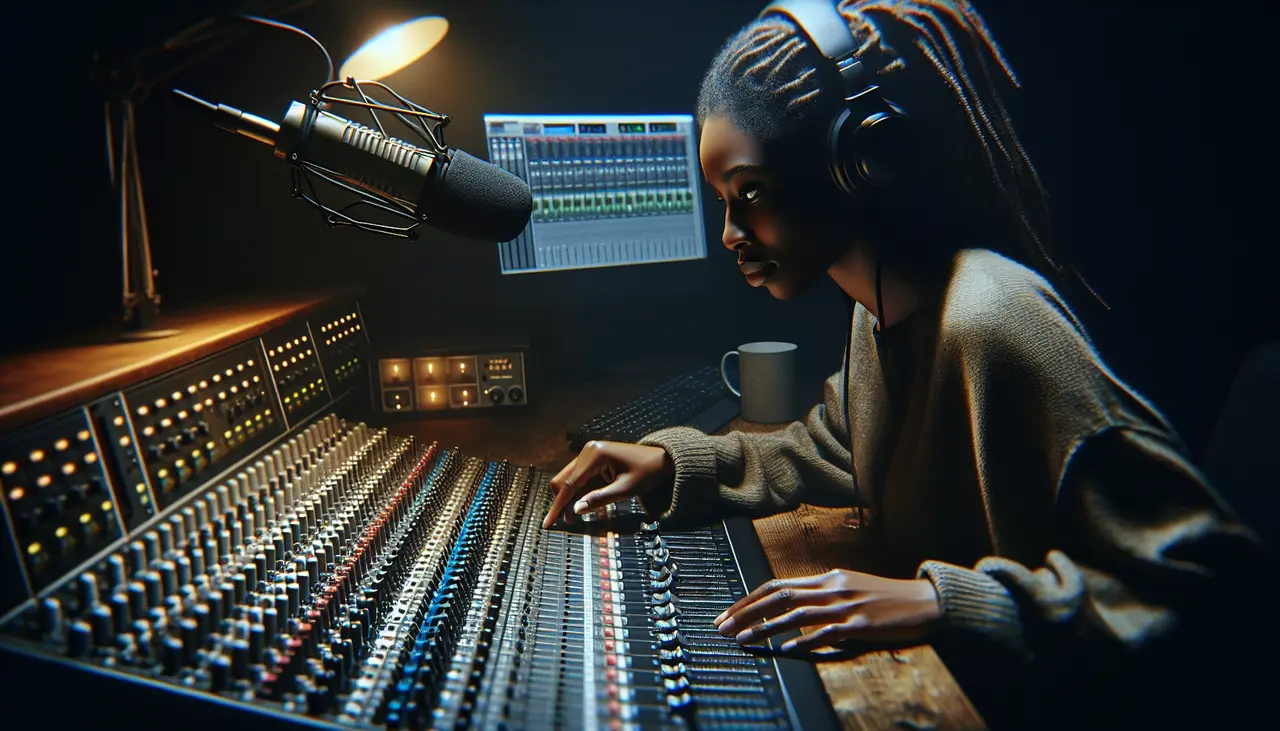Introduction: The Art of Sound in Thriller Audiobooks
When you listen to a thriller audiobook, the chills down your spine aren’t just from the story. A big part of that eerie feeling comes from the sound effects. These aren’t your everyday sounds. Sound artists craft them carefully to get under your skin, making your heart race just a bit faster. Imagine footsteps in an abandoned hallway, the distant sound of a child’s music box in an empty house, or the sudden scream that makes you jump. These sounds are designed to pull you deeper into the story, making the experience intensely real. They play with silence, too, using it just as effectively as any spooky sound. Silence builds tension, making you wait, listen harder, and then, when you least expect it, comes a sound that makes your skin crawl. Next time you listen to a thriller audiobook and find yourself looking over your shoulder, thank the sound artists. They’re the unsung heroes who know exactly how to use the art of sound to make your heartbeat match the pace of the story.
The Role of Sound Effects in Enhancing Horror and Suspense
Sound effects aren’t just noises in the background of horror and suspense audiobooks. They’re the unsung heroes, the spine-chilling whispers in the dark that make your heart skip a beat. When an audiobook nails its sound effects, you’re not just listening; you’re there, in the thick of it, feeling every suspenseful moment and jumping at every unexpected sound. It’s all about immersion. Creepy footsteps, eerie howling winds, or the sudden slam of a door can transform a simple story into a vivid, terrifying experience. These sounds play with your imagination, making you anticipate something lurking around the corner, even if it’s broad daylight and you’re safe in your room. They set the mood, build tension, and can even mislead you, making you think something’s going to happen when it’s just a false alarm. It’s this blend of anticipation and surprise that keeps you on the edge of your seat, hooked till the very end. Good sound effects in horror and suspense aren’t just about being loud or shocking; they’re about being right. They echo the story’s heartbeat, syncing perfectly with the narrative to amplify the thrill without overshadowing the story itself. That’s the magic—when done right, you might not even notice them consciously, but they leave you with that eerie feeling of suspense, making every twist and turn in the story that much more impactful.
Starting with Silence: The Base of Every Great Sound Effect
When making those heart-pounding sound effects for thriller audiobooks, it all begins with silence. Yup, silence. Think of it as a blank canvas for artists. In that quiet, creators can shape any sound without background noise messing things up. They use high-quality microphones to catch every tiny detail, from the softest whisper to the loudest scream. This crisp starting point means you can hear the difference between footsteps on gravel and leaves, making it feel like you’re right there in the story. So next time you jump at a sound while listening to a thriller, remember, it all started in the quiet.
Tools of the Trade: Equipment Used in Creating Eerie Sounds
When it comes to chilling your spine with eerie sound effects in thriller audiobooks, the magic happens with some special tools. Audio experts lean on a blend of traditional and high-tech equipment to pull this off. First up, digital audio workstations (DAWs) sit at the heart of the operation. These software powerhouses allow sound designers to record, edit, and mix sounds, crafting them into the gripping effects that keep you on the edge of your seat. Then, there’s the microphone—not just any mic, but professional-grade ones that capture every nuance of sound, from the faintest whisper to the loudest scream.
Field recorders are the unsung heroes, letting creators capture natural sounds out in the wild—creaky doors, howling winds, you name it—that add authenticity to those heart-pounding moments. Software plugins and sound libraries are the spice rack, filled with pre-recorded sounds and effects that can be twisted and turned into something new. Lastly, creativity is unleashed with items you might not expect. Think of using a cello bow on a metal sheet to create that eerie screech or rustling foil to mimic crackling fire. These tools, combined with a dash of creativity, deliver the chills and thrills that make thriller audiobooks unforgettable.
From Concept to Creepiness: The Process of Designing Sounds
Designing sounds for thriller audiobooks is more than just hitting record. It’s an art form that transforms the ordinary into the heart-pounding. The journey begins with the concept. Sound designers read the story, absorbing every detail, every twist, and every dark corner. Their goal? To find the perfect sound for each moment that makes your spine tingle. Next is the experimentation phase. Here, designers play around with different objects and recording techniques. They might scratch a chalkboard, rustle leaves, or manipulate digital effects to create something utterly new. It’s a trial and error process, where the creepiest sounds are born from the most unexpected sources. Then comes layering, mixing different sounds together to heighten the suspense. A door’s creak, footsteps, whispering voices—when combined, they make your imagination run wild. Finally, it’s all about refining. Sound designers tweak levels, add echoes, or adjust pitches until each sound perfectly fits the scene’s mood. From concept to creepiness, it’s a meticulous process, but it’s how they ensure every listen is a thrilling experience.
Foley Artistry: Bringing the Unseen to Life
Foley artistry is like being a magician for your ears. Picture this: you’re listening to a thriller audiobook, heart racing, as footsteps creep up behind the protagonist. That shiver down your spine? Thank a Foley artist. They make those footsteps sound real by walking on different surfaces, wearing various shoes. It’s all about capturing the right sound at the right moment. A door creaks open, leaves rustle, a glass shatters – it’s their job to make you feel like you’re right there, in the thick of the action. They use anything from props to their own bodies to produce sounds that aren’t recorded during the initial voice recording. Imagine making thunder with a thin metal sheet or rain with rice falling on a tin roof. That’s the unseen world Foley artists bring to life, layering sound upon sound to fill your ears with suspense and surprise. Each sound effect is tailored to fit the scene, ensuring that the audience stays hooked, their imagination vividly painting every scene. Through skill, creativity, and precise timing, Foley artists turn silence into a canvas of auditory thrill.
Manipulating Sound: Techniques to Elevate Tension
Creating those goosebump-inducing sounds in thriller audiobooks isn’t magic; it’s all about clever manipulation. Sound designers use various techniques to get under your skin. One popular method is pitch shifting, where they play sounds at a higher or lower than normal pitch to make you feel uneasy. They also play with reverb, adding an echo effect that makes a space feel eerie or vast, perfect for setting a haunting scene. Layering is another trick up their sleeve, combining different sounds to create a complex, unsettling effect. Imagine the sound of footsteps not just being footsteps, but a concoction of rustling leaves, a creaking floor, and a faint, whispery breath. Lastly, they often use contrast, switching abruptly between loud and soft sounds to keep you on edge. All these techniques work together to make those spine-tingling moments in your favorite thriller audiobooks truly memorable.
The Psychology Behind Fear-Inducing Sounds
Fear has a sound, and it’s surprisingly something we’re all wired to recognize. When we hear certain sounds, like a sudden, shrill scream or the eerie creak of a door, our brain jumps into high alert. This isn’t by chance. Part of our brain, called the amygdala, takes charge. It’s like our body’s watchman, always on the lookout for danger. When it hears something that could mean trouble, it shouts, “Watch out!” and pumps adrenaline through us, making our heart race and our senses sharpen. This is why in thriller audiobooks, certain sounds make the hair on the back of your neck stand up. The creators behind these sounds know what they’re doing. They use specific sounds that our brains instinctively find scary. Low, rumbling tones can make you feel uneasy. The sudden, high-pitched screech of violins can make you jump. It’s all about playing with your brain’s natural fear response to keep you on the edge of your seat, glued to the story. So next time you feel a shiver listening to a thriller, know there’s a science to scare.
Collaboration with Authors and Narrators for the Perfect Ambiance
Getting the ambiance right in thriller audiobooks is critical. It’s not just about adding random creaks or sudden screams; it’s an art. That’s where the magic of collaboration between authors, narrators, and sound designers comes into play. Authors often have a precise idea of the atmosphere they want to create. They paint the scenes with words, and it’s up to the narrators and sound designers to bring these words to life. Narrators use their voice to set the tone, pacing the story in a way that hooks listeners, making their heart race or their skin crawl. Meanwhile, sound designers layer in effects subtly. Imagine a scene where the tension is building – the sound of soft footsteps or the distant echo of a door closing can make all the difference. It’s a team effort. Everyone has one goal: to keep you on the edge of your seat, eagerly anticipating what happens next. This collaboration is the backbone of crafting a soundscape that feels as real as the story being told.
Behind the Final Cut: Mixing and Mastering for Audiobook Platforms
Mixing and mastering are the unsung heroes in the making of a thriller audiobook that sends shivers down your spine. After all the recording is done, it’s time to blend all those eerie footsteps, whispers, and mysterious background noises perfectly. This step ensures every sound plays at the right moment, at the right level, making the story come alive in the listener’s mind. Mastering then polishes the final mix, balancing sound levels and quality so that no matter where you’re listening—be it on a noisy train or in a quiet room—the experience is just as immersive. Each platform, from Audible to Spotify, has its own requirements for audio files. That means tweaking the files to meet standard loudness levels and format specifications, ensuring a smooth, no-hassle listening experience for everyone. This behind-the-scenes magic is crucial for that edge-of-your-seat feeling, making sure the scares hit just right, every time.


